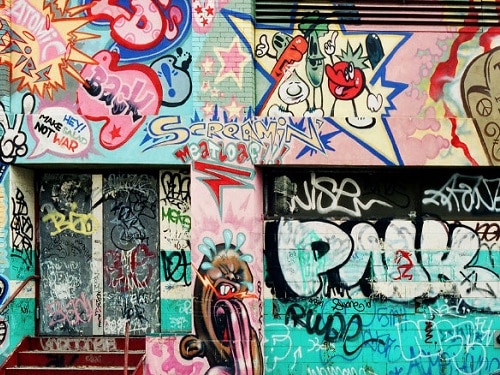At the turn of the millennium, emerging graffiti artists began creating their own typography and developing their own approaches – many inspired by Arabic calligraphy or automatic spray-paint writing. Street Art continues to evolve, but still following the principle that each new generation of artists defines and refines its own styles while maintaining a collective culture and a shared basic foundation. Many different voices, as well as critical responses are emerging as the movement spreads to every continent.
Highlights

Tarek Benaoum (b. 1978)
La quête de l'immortalité, Gilgamesh
(Gigamesh: The Quest for Immortality)
Created on site at the ArtScience Museum
January 2018
From the age of 14, Benaoum was captivated by graffiti and chose spray paint as his medium for his early works. As he explored, he turned towards calligraphy and he regards this now as a continuation of his passion for writing. He trained at the Toulouse Scriptorium, an art school established in 1968 to support the teaching of calligraphy and typography, and there he found the freedom to explore other forms of self-expression including the use of fractured words, phrases, quotations, poems and aphorisms. Benaoum explores a non-conformist and innovative ‘jamming’ which one could describe as ‘calligraffiti’ style.


Eko Nguroho (b. 1977)
Garden Full of Blooming Democracy
Created on site at the ArtScience Museum
January 2018
Although he was trained at the Indonesian Art Institute and his work presented in galleries and museums, Nugrohoʼs work is deeply anchored in the urban environment. He is renowned for combining both Indonesian artistic traditions, such as batik along with global pop culture. Nugroho is a multidisciplinary artist and works in a variety of media including painting, sculpture, embroidery, tapestry and installations, as well as street art, animation and video.

Remi Rough (b.1971)
Concise
Created on site at the ArtScience Museum
January 2018
Remi Rough is one of the UK's leading post-graffiti artists. Rough began as an ‘old school’ graffiti artist, painting letters on public walls and trains in south London in 1984. Today, the artist has gone from walls to canvas and is exhibits his work regularly. With his very abstract and architectural style, his practice is often compared to visual haiku. Rough was able to translate the work he made outside into his studio without losing his distinctive style.


Rero (b. 1983)
One More Picture On My Phone, 2017
Digital wallpaper print
Courtesy of the artist
Courtesy of the artist
In his approach, the French artist Rero distinguishes himself by playing with the supposed border between Street Art and contemporary art. He paints messages in huge letters that he then crosses out. The meaning, seemingly obvious at first glance, raises more questions than it answers. Although steeped in Street Art culture, he seeks to question his fellow artists.

Tanc (b.1979)
Untitled, 2015
Acrylic paint on canvas
Courtesy of Magda Danysz Gallery
Photo: courtesy of Magda Danysz Gallery
Untitled, 2015
Acrylic paint on canvas
Courtesy of Magda Danysz Gallery
Photo: courtesy of Magda Danysz Gallery
While he grew up with graffiti, very early on Tancrède Perrot, or Tanc as he is generally known, realised that art in the street is ephemeral – once created it could disappear at any moment. For him the action of creating became more important than the end result. His signature style is formed around the use of lines that cross and weave and in turn link with his practice as a musician. By focusing on music, rhythm, line and colour, he renewed a classic pictorial research style of Street Art while perfecting the gesture and mark making and accepting that the work might be temporary.


